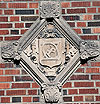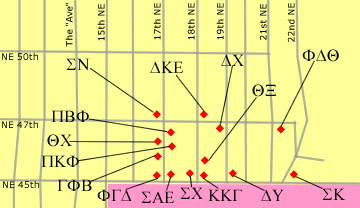
 While Most Huskies Take Them for Granted, Our Greek Row Houses are Architectural Gems that Some Day Might Comprise a Historic District. Greek Row at the University of Washington is unique, perhaps unprecedentedly so, in the cohesiveness of its neighborhood. At most universities, if fraternities and sororities are built off campus, the rows are ordinarily a scattering of Greek-letter houses located in some spontaneous pattern at varying distances and directions. But at Washington, we find a Greek Row with none of that scatteration. Instead, ours has a remarkable coalescence of houses almost entirely confined in the first blocks due north of the campus, comprising not much more than seven blocks dominated almost entirely by Greek-letter student housing groups. In this area, most houses were built in the 1920s and early '30s, affording a certain unity in design and volume, although many were altered in the post-war years. Most followed one of two architectural styles of the period—Collegiate Tudor/Gothic or Georgian Revival. And many renowned Seattle architects lent their considerable skills to these projects, including NBBJ co-founder William Bain Sr., the iconoclastic Ellsworth Storey, longtime UW Architecture Professor Lionel "Spike" Pries, the prolific Arthur Loveless (his firm designed at least five Greek houses) and UW Architecture Dean Harlan Thomas. While our current student residents might be surprised at the designation, the neighborhood could one day be named an official historic district. Indeed, one could start the process today with some of the older houses, which are more than 80 years old. But the history of the Greeks at the University of Washington goes back more than 100 years. It started in 1896 with the founding, among fraternities, of the Sigma Nu chapter, followed in 1900 by both Phi Gamma Delta and Phi Delta Theta, in 1901 by Beta Theta Phi and, in 1903 by both Sigma Chi and Kappa Sigma. The first sororities were Delta Gamma and Gamma Phi Beta in 1903 and Kappa Kappa Gamma in 1904. As they began their inroads into the social patterns of the University, choices by the Greeks for housing locations proved to be rather limited. Both to its east and south, the campus was edged in large part by Lake Washington and Portage Bay (soon augmented by the Montlake Canal). And to the west of campus, there already existed a community, mostly residential with some commercial development, which provided possibilities for temporary acquisition but was unpromising for more ambitious plans. In the University District, that left the area north of campus as having any promise of future development, but only the blocks west of 15th Avenue N.E. were platted. The earliest Greek-letter houses therefore had to do with what was available; the 12 houses existing in 1908 were almost entirely above N.E. 45th Street and to the west of 15th Avenue N.E. There was still the promise of future possibilities in that undeveloped area north of 45th and east of 15th whenever its owners chose to release it. This they did in 1906, when the land came on the market as the University Park Addition with new streets and blocks stretching from 15th to 20th Avenue and north from 45th Street to 55th. |
|
- Return to September 2001 Table of Contents
